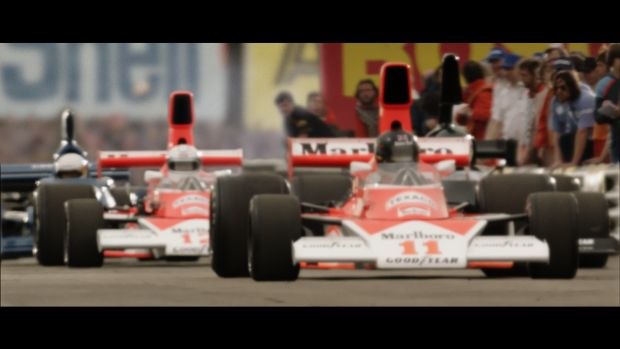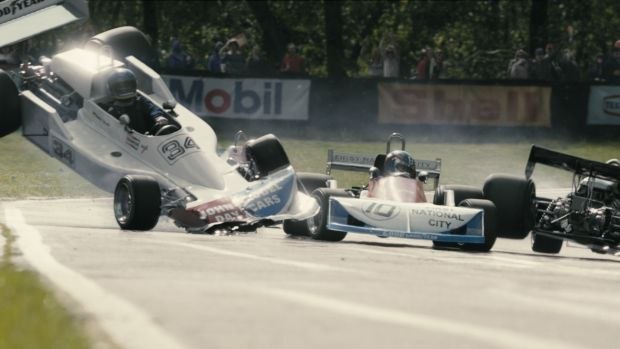Double Negative's Jody Johnson describes the unique VFX collaboration in Ron Howard's racing biopic.
Double Negative's VFX contribution to Ron Howard's Rush, the fact-based Formula 1 rivalry in the '70s between drivers James Hunt (Chris Hemsworth) and Niki Lauda (Daniel Bruhl), was very much about helping create the distinctive look, which captured the colorful sex, glam and energy of the period.
However, Oscar-winning cinematographer Anthony Dod Mantle (Slumdog Millionaire) didn't have the budget to recreate the various race tracks and locales throughout the Formula 1 circuit, so he had to develop a way of creating his own unique production values with archival footage.
"The editors gathered together hours and hours and hours of racing footage (both 35mm and 16mm), and we got together with Ron and Anthony and looked at ways of using the material, explains Double Negative VFX supervisor Jody Johnson. "We needed to work out if it was going to be useful and, if so, how we could use it. We looked at production value, storytelling moments and stylistic compatibility.
"There were a lot of characters in the pit lane and visually it's very colorful, very graphic and very messy. There was lots of movement, and the cars are very beautiful and the tracks were often set in interesting landscapes such as Monaco and Fuji. Ron wanted each race to have its own look and energy.
"We identified what would hold up in the film. We went back to original neg and scanned that and took it back to DNeg and shot tests on the various camera formats Andrew was using (the Alexa, the Canon C300, the miniature IndieCam), and we put together little edits with mixed media and worked to blend them. At one extreme, we'd have the Alexa and at the other extreme we'd have broken archive material. And we brought them closer together by making the archival footage look cleaner, more modern and more stable. We also did the inverse to some of the Alexa tests and ended up with an edit with all different file formats that didn't bump. Anthony didn't it want to be a mixed media film. He wanted it to be cohesive, so we explored degraining, stabilizing, getting rid of dirt and scratches. We also tracked a lot of the archive material and digitally reprojected some of the areas of the negative back unto itself if it was too damaged to repair."
For example, at Nürburgring, there was a helicopter shot over the grandstand that Howard really liked, but he didn't have the right cars, the colors and grain were inconsistent and helicopter movement was all over the place. So DNeg tracked it, stabilized it, rebuilt some of the architecture (such as the roof of the grandstand) and then added the correct cars and VFX and wet down the track.
"When shooting we knew what we would be adding," Johnson continues," and what kind of atmosphere the tracks had, so it helped with the technical planning of where to put the camera and it helped Anthony with the style of the camera moves and lenses (from the '60s and '70s to achieve the right chromatic aberration and the way focus falls off quite quickly).
"To get the performance of the cars right, we tested both the behavior of the cars and the style of the drivers. We went to Lotus and shot test material of period correct cars and we worked with a Formula 1 team to piggy back their simulator and expanded on that to work within our pipeline and tailored to our specific needs."
Therefore, with a simulator in the VFX house, the animators could select a track that was in the film, select the cars and race them and simulate their behavior and block shots out like a sophisticated videogame. And then they could put that animation in the shots.
"The simulator was like a cockpit with three video screens and we got some software from one of the Formula 1 teams and added the behavior of the correct cars back into the simulators. We tailored the physics in the simulator to match the period correct cars and built models of the tracks that we were going to be shooting at. We could jump onto the simulator, do a few passes of a specific section of a race and then output that into Maya and put it onto DNeg's animation rig. They could layer more animation or more physics-based simulation on top of that. It was a good starting point."
Howard wanted Nürburgring to have pomp and circumstance and it's also the turning point in the story when Lauda nearly burns to death when he goes off the track and crashes. DNeg prevised the entire race and developed ideas and choreography of cars and cameras so Howard knew what story beats he needed to sell in the races and explore the best way to convey them.
"We produced edits mixed with archival material and test material. It was a way of stylistically selling speed, drama and where to mount cameras without having to physically rig them.
"The crash was a pivotal moment in the film and our biggest sequence. These Formula 1 drivers were being killed and this was a high profile, horrific crash. It happened to be captured on 8mm by a kid, so it was famous. It had to be historically accurate but we went further in exploring what caused the crash and how the car might've behaved: what would've caused the smoke and characteristic dirt, dust and fire patterns. It had to be authentic and dramatic.
"It was a difficult balancing act to use such a demanding discipline to create such a visceral and random moment. It was the first sequence we started and the last we finished. We explored a lot of tools to give us the best results for each small piece within the shot, so some software is better for dynamic fire, some software is better for white puffy smoke, some is better for the dirt. We broke it down into component parts. We used mostly Houdini and DNeg's proprietary Squirt fluid simulation. We also used Dynamite for hard objects. We developed ways of lighting and texturing those simulations to give them the right transparencies and volume and interactive lighting from the fire."
Johnson concludes that to get these echoes from the past was imperative. "We started to understand more about what made Formula 1 exciting as a sport." This is more than mere VFX: it's an integral part of Rush's aesthetic and storytelling.
--
Bill Desowitz is former senior editor of AWN and VFXWorld and the owner of Immersed in Movies (www.billdesowitz.com). He's also a columnist for Thompson on Hollywood at Indiewire and contributing editor of Animation Scoop at Indiewire. Desowitz is additionally the author of James Bond Unmasked (www.jamesbondunmasked.com), which chronicles the 50-year evolution of 007 on screen, featuring interviews with all six actors.






















